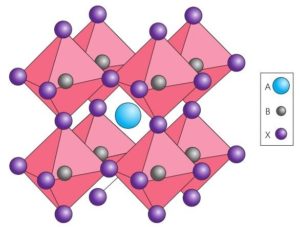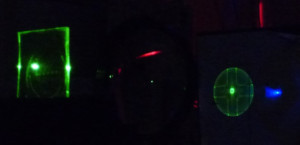Hybrid Perovskites
Hybrid perovskites are an exciting new class of semiconductor that combine the advantages of both organic (low cost, solution processable, flexible) and inorganic semiconductors (high performance, electrical conductivity).

They first saw use as a solar cell material, where they have rapidly risen to become competitve with silicon in the space of just a few years, but they have found use in most optoelectronic devices.
Our Work
Perovskite Solar Cells
Perovskite solar cells (PSCs) have risen rapidly in efficiency from 4% in 2009 to 23.3 % in 2018. Our work focuses on studying the photophysics and energy levels of hybrid perovskites in order to understand what makes these materials so efficient. We make perovskite solar cells and test their device performance with a solar simulator, whilst also using time resolved photoluminescence and Kelvin probe measurements to probe more deeply into the bare material’s physics. This insight helps us design new material compositions, transport layers, or device structures to help push the performance of PSCs even higher, and also provides valuable data for our collaborations with the department of chemistry to design new variations on perovskites with enhanced properties such as lowered toxicity or improved stability.
Perovskite Lasers
One of the key things which makes PSCs so efficient is their high tolerance to defect states, which also makes them excellent light emitters. We have exploited this property to use perovskites as a gain medium in thin film lasers, where their versatile crystal structure and resistance to photodegradation allow highly stable lasers which can in principle be tuned to any colour of the spectrum. Perovskite lasers combine many excellent properties, which together could make them compatible with direct electrical pumping – a key aim in all laser designs. Our aim is to use perovskites to create a new class of laser diode, which would have many commercially important applications.

Perovskite LEDs
Perovskite LEDs have very recently attracted interest because they can produce extremely bright emission with highly pure colours, whilst still being easily solution-processed for large-area emission. Additionally, their efficiency is not limited by the presence of triplet excitons which are problematic in organic LEDs.


Our work focuses on designing new classes of highly emissive perovskite structures for LED applications, and on designing new processing methods which will allow the easy patterning of perovskite LEDs into the multicolour arrays used in displays.